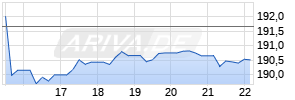
J.P. Morgan Research Reveals Defined Contribution Participants Continue to Save Too Little, Take Loans and Withdraw Quickly After Retirement
PR Newswire
NEW YORK, Dec. 13, 2018
NEW YORK, Dec. 13, 2018 /PRNewswire/ -- J.P. Morgan Asset Management today released the latest installment of its Ready! Fire! Aim? research series, examining the saving and withdrawal behaviors of defined contribution plan participants and the implications for target date fund design. This year's findings continue the trend witnessed over more than 10 years of Ready! Fire! Aim? research, revealing that participant behavior is much more varied and volatile than many target date fund providers assume, with significant ramifications around retirement outcomes.
"The latest Ready! Fire! Aim? report reveals that many plan participants still aren't positioned for retirement income success despite the efforts of plan sponsors, their advisors, and plan providers. In this year's expanded research, we also were able to identify and analyze the wide variation in behavior across income groups, demonstrating the need for plan sponsors to take into account the personal nature of retirement saving and spending in plan design," said Anne Lester, Portfolio Manager and Global Head of Retirement Solutions, J.P. Morgan Asset Management. "It's also critical for target date fund managers to develop asset allocation models that reflect the fact that participant assets are most vulnerable to account losses in the years leading up to retirement and immediately after."
This year's research included an expanded participant universe, drawing upon data from MassMutual Financial Group and Empower Retirement, who are recordkeepers for more than 4,000 defined contribution plans serving approximately 2 million participants.
Evaluating Participant Behavior Patterns
Ready! Fire! Aim? once again finds persistent and wide variations in saving and investing behavior, impacting the success of retirement plans. Key behavioral trends among participants in the latest analysis include:
- Automatic enrollment continues to expand participant engagement, particularly among younger investors.
More than half of 25-year old participants investing in a plan were automatically enrolled, suggesting that some of these participants may not have invested in the plan otherwise. This large percentage of younger defaulted participants emphasizes the positive influence plan sponsors can have by setting employees on a constructive retirement savings path, while also getting them to start investing for retirement early in their careers. However, when not paired with automatic contribution escalation, automatic enrollment on its own may have unintended consequences.
- On the downside, contribution rates remain too low, driven by passive participants.
Unfortunately the average contribution rate for passive participants, those who were automatically enrolled in the plan and never made contribution changes, fell significantly below those participants who took action to adjust their contribution rates. A sizable segment of participants are starting average contributions at a minimum 3.3% rate and failing to take any action other than what the plan sponsor makes on their behalf to increase contributions. Disappointingly, even at the higher end of the salary spectrum, many participants are still simply contributing far too little.
- Middle income earners are most likely to take a loan from their retirement account.
Only wealthier participants at the higher end of the average contribution rate spectrum are even approaching the savings rate of at least 10% recommended by many industry experts. Meanwhile, middle income earners are most likely to take a loan, and lower-income earners continue to make larger post-retirement withdrawals relative to the other two segments as well.
- The majority of participants continue to make substantial withdrawals soon after retiring.
The research shows that the average participant withdrew more than 55% in any given year at or soon after retirement. From an age perspective, the research again found that withdrawals once participants reach 59½ distributions were substantially higher than general industry expectations. In addition, just 28% of participants remain in their retirement plan three years after retirement.
Implications for Plan Sponsors
In light of the participant insights revealed in the 2018 Ready! Fire! Aim? report, there are a number of key learnings for plan sponsors who seek to improve participant outcomes:
- Plan sponsors may want to look beyond getting employees into the plan.
While getting employees into the plan is a good first step, to truly drive retirement funding success plan sponsors and their advisors may want to focus on encouraging higher contribution rates. This can be achieved explicitly by implementing automatic contribution escalation programs at a much higher rate increase than typically used today.
- Educational efforts should focus on employees at the middle and lower salary levels
Findings across salary levels indicate a real need to pay even greater attention to educational efforts targeting employees at middle and lower salary levels, who tend to save less, borrow more and withdraw earlier than other participants. Implementing automatic enrollment and automatic contribution escalation programs have also proven to be effective strategies for placing these participants on a more secure retirement savings path.
- Target date fund design needs to take into account the personal nature of retirement spending in the years leading up to retirement and immediately after.
Participant withdrawal behaviors vary widely, from those who quickly cash out their accounts, to those who rollover their assets into other retirement accounts, and those who use them to help fund increased post-retirement spending. Plan sponsors and their advisors should incorporate the full range of these behaviors into plan design, including evaluating appropriate levels of equity exposure in target date fund glide paths. It's also critical to keep in mind that participant assets are most vulnerable to account losses in the years leading up to retirement and immediately after.
"This edition of the Ready! Fire! Aim? report confirms our view that a well-designed target date fund offers the greatest chance of retirement security for the vast majority of participants," said Daniel Oldroyd, Head of Target Date Strategies, J.P. Morgan Asset Management. "When it comes to guiding participants safely over the retirement finish line, proactive plan design can be just as important as investing and asset allocation."
"We maintain our position that a broadly diversified glide path with a focus on dynamic risk management, such as the JPMorgan SmartRetirement glide path, continues to secure the greatest number of projected participant retirement funding successes," concluded Mr. Oldroyd.
ARIVA.DE Börsen-Geflüster
Weiter abwärts?
| Kurzfristig positionieren in JP Morgan Chase Corp. | ||
|
UL0ZQA
| Ask: 3,08 | Hebel: 5,68 |
| mit moderatem Hebel |
Zum Produkt
| |

Kurse
 |
To learn more about J.P. Morgan Asset Management's leading DC investment strategies, product innovations and resources for advisors and plan sponsors, please click here, or to view the full Ready! Fire! Aim? white paper, and full research methodology, please click here.
About J.P. Morgan Asset Management
J.P. Morgan Asset Management, with assets under management of $1.8 trillion (as of September 30, 2018), is a global leader in investment management. J.P. Morgan Asset Management's clients include institutions, retail investors and high net worth individuals in every major market throughout the world. J.P. Morgan Asset Management offers global investment management in equities, fixed income, real estate, hedge funds, private equity and liquidity.
JPMorgan Chase & Co. (NYSE: JPM) is a leading global financial services firm with assets of $2.6 trillion (as of September 30, 2018) and operations worldwide. The Firm is a leader in investment banking, financial services for consumers and small businesses, commercial banking, financial transaction processing, and asset management. A component of the Dow Jones Industrial Average, JPMorgan Chase & Co. serves millions of customers in the United States and many of the world's most prominent corporate, institutional and government clients under its J.P. Morgan and Chase brands. Information about JPMorgan Chase & Co. is available at www.jpmorganchase.com.
For target date funds the target date is the approximate date when investors plan to start withdrawing their money. Generally, the asset allocation of each Fund will change on an annual basis with the asset allocation becoming more conservative as the Fund nears the target retirement date. The principal value of the Fund(s) is not guaranteed at any time, including at the target date.
J.P. Morgan Asset Management is the marketing name for the asset management businesses of JPMorgan Chase & Co., and its affiliates worldwide.
![]() View original content:http://www.prnewswire.com/news-releases/jp-morgan-research-reveals-defined-contribution-participants-continue-to-save-too-little-take-loans-and-withdraw-quickly-after-retirement-300764916.html
View original content:http://www.prnewswire.com/news-releases/jp-morgan-research-reveals-defined-contribution-participants-continue-to-save-too-little-take-loans-and-withdraw-quickly-after-retirement-300764916.html
SOURCE J.P. Morgan Asset Management

Mehr Nachrichten zur JP Morgan Chase Corp. Aktie kostenlos abonnieren
(Mit der Bestellung akzeptierst du die Datenschutzhinweise)

Hinweis: ARIVA.DE veröffentlicht in dieser Rubrik Analysen, Kolumnen und Nachrichten aus verschiedenen Quellen. Die ARIVA.DE AG ist nicht verantwortlich für Inhalte, die erkennbar von Dritten in den „News“-Bereich dieser Webseite eingestellt worden sind, und macht sich diese nicht zu Eigen. Diese Inhalte sind insbesondere durch eine entsprechende „von“-Kennzeichnung unterhalb der Artikelüberschrift und/oder durch den Link „Um den vollständigen Artikel zu lesen, klicken Sie bitte hier.“ erkennbar; verantwortlich für diese Inhalte ist allein der genannte Dritte.


